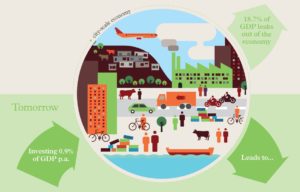
Brief outline of the low carbon town development plan
Palembang has a population of 1.5 million and an economy worth IDR 54 trillion (US$4.59 billion). Our research found that the total energy bill for the city was IDR 10.1 trillion (US$857.2 million) – meaning that 18.7% of everything earned in the local economy is spent on energy. With ‘business as usual trends’ including rapid population growth, projected energy price increases and rising carbon intensity of electricity, we forecast that energy bills will increase by 155.1% and carbon emissions by 164.6% by 2025, relative to 2014 levels.
Based on an evaluation of the performance and scope for deployment of 130 energy efficiency, renewable energy and low carbon measures across the electricity, commercial, domestic, industrial, transport and waste sectors, we forecast that Palembang could cut its energy bills by IDR 5.1 trillion (US$436.8 million) and reduce emissions by 24.1% relative to business as usual levels by exploiting cost-effective measures that would pay for themselves on commercial terms. We calculate that, in this scenario, the city could secure investments worth IDR 4.8 trillion (US$405.6 million) that would pay back in less than one year. By re-investing the returns from these investments in low carbon measures, Palembang could reduce its energy bills by IDR5.5 trillion (US$467.4 million) and carbon emissions by 28.3% by 2025, relative to 2014 levels, at no net cost to the city.
Our research is conducted in partnership with the Indonesian Ministry of Transport and is supported by the UK Foreign and Commonwealth Office, the Centre for Low Carbon Futures and the ESRC Centre for Climate Change Economics and Policy.
What are CO2 emissions reduction target and date to achieve this?
28.3% CO2 emissions reduction by 2025.